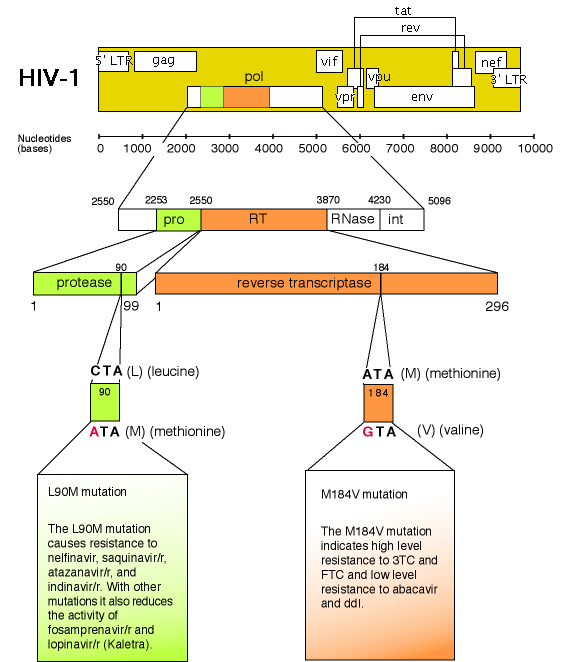
9. Appendix 5: The HIV genome map
This graphic is a map that simplifies the genetic structure of HIV into nine main genes.
These are gag, pol, vif, vpr, vpu, env, tat, rev and nef.
The map shows roughly how these genes are laid out in HIV-1.
Each gene has a different role in the HIV life cycle. You don’t need to learn all these functions, just recognise that we know roughly what many of the functions are. For example env is easiest to remember because it is the recipe for spiky proteins that stick out from the ‘envelope’ coating on the outside of the virus.
Pol is important when talking about drug resistance. This is because this section of the HIV genome has the code for the enzymes that are targeted by many HIV drugs. These include protease inhibitors (PIs), reverse transcriptase inhibitors (nukes and non-nukes) and integrase inhibitors.

The numbers underneath the main picture relate to the 9700 bases (roughly 3,200 amino acids) that make up the genetic structure of HIV. Pol starts at number 2550 and stretches to 5096.
The protease section in pol stretches from 2253 to 2550. This is a chain of 297 nucleotides, which equals 99 amino acids (amino acids are groups of three nucleotides).
Therefore, the protease gene is numbered from 1 to 99. The example here is L90M which is a common PI mutation.
In a similar way the amino acids in reverse transcriptase are numbered from 1 to 296. A change at position 184 on the RT gene from ATA to GTA is the M184V mutation.
Genotype resistance tests do not need to look at the whole of the HIV genome. They only need to look at this short section to get information about resistance to nukes, non-nukes and PIs.
Resistance tests for entry inhibitors like T-20 need to look at a section of the env. Resistance to integrase inhibitors needs a test that looks at a small section on the integrase section of the pol gene.
This diagram is based on a more detailed map of the HIV-1, HIV-2, and SIV genomes, available at:
hiv-web.lanl.gov/content/immunology/pdf/2000/intro/GenomeMaps.pdf
For an explanation of what these different genes do see the i-Base FAQ:
HIV genome: genetic structure and function of HIV explained
If you feel really geeky, then check it out, but let the rest of the information in this section sink in first.
Last updated: 1 January 2023.
